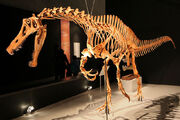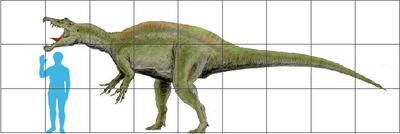
Irritator reconstructed skeleton
Irritator is a species of Spinosaurid Dinosaur closly related to the giant Spinosaurus. It is very probable it is synonymous with Angaturama, which is from the same time and place as Irritator. These two, together with Spinosaurus, form the sub family Spinosaurinae within Spinosauridae. The type and only species is I.challengeri, named in honour of Professor Challenger from The Lost World novel.
Description[]

Irritator with a human for scale.
Irritator was a medium sized theropod, at around 8m in length and 2t in weight, it was of a simillar size to both Baryonyx and Angaturama (which as previosuly mentioned may be synonymous with Irritator). Like many Spinosaurids, it probally possed tall spines along its back. If it is indeed Angaturama then it did posses these tall spines. Like most spinosaurids, it would have had a slender build with long, powerful forearms.
Fossils[]
Material of I. challengeri, not counting that of A. limai, hails from the Romualdo Member of the Santana Formation in Brazil. The holotype is SMNS 58022, from the Stuttgart State Museum of the Natural Sciences, and it consists of an incomplete skull, lacking the anterior (front) portion. The skull was recovered nearly complete and is considered the most complete head find of a Spinosaurid. It is characterized particularly by its unusual length and curved lip region, which is strongly compressed laterally. The overall length of the complete head is estimated at approximately 84 centimeters. It possesses a clear Sagittal crest; such a comb is found also with some other dinosaurs. The teeth exhibit a single embedding of the strongly extended and straight teeth with conical tooth crowns, which indicates a continual tooth change, as new teeth were pushed up between the old ones. The teeth exhibit lengths from 6 to approximately 40 millimeters.
In the year 2004 parts of a spinal column were discovered in the Santana Formation. These have been assigned, due to their structure, to the Spinosauridae. With very high probability these fossils belong to Irritator, since this is the so far the only so far well-known Spinosaurid of the formation.
Angaturama limai[]
Angaturama limai, from the same time and place as Irritator challengeri, was described by A. Kellner and Diogenes A. Campos in February 1996 on the basis of a fossil from the Santana formation. It was named after Angaturama, a protective spirit in the aboriginal Tupi Indian culture of Brazil, and paleontologist Murilo R. de Lima, who informed Kellner of the specimen in 1991. Later research uncovered 60% of the complete skeleton, allowing a replica to be made and mounted for exhibit at the Federal University-owned Rio de Janeiro National Museum.[2]Angaturama was diagnosed by the very strong lateral compression of the snout, and a thin sagittal crest (shape unknown) on top of the premaxillae. Fish may have formed a large part of its diet. However, a pterosaur fossil was found with an Angaturama tooth embedded in it, pointing to possible predation. Today many sources consider Angaturama a synonym of Irritator.[3][4][5] Some scientists have even speculated that the two partial fossil skulls come from the same individual. Waiters and Campos (2000) as well as Machado and Waiters (2005) hold however the opinion that the fossils come from two different genera and that Angaturama had a clearly higher and laterally more flattened head than Irritator. If Angaturama and Irritator are actually regarded as a member of the same genus, Irritator challengeri would be the valid scientific name under the priority rules.
The fossil consists only of the front part of the head, which is characterized by the fact that it is very narrow and carries a premaxillary sagittal crest. In the premaxilla a broken-off tooth with partial tooth crown was recovered which corresponds to that of Irritator. Altogether the premaxilla had seven teeth; the third tooth was the largest. The fossil is kept today under the number USP GP/2T-5 in the Universidade de São Paulo.